Lorenzo Lotto (Venice, 1480 - Loreto, 1556/1557) was a restless and wandering painter: born in Venice and trained in the lagoon, he found no space in his hometown because of his extremely innovative and original, as well as unconventional and anticlassical, painting. He was thus always forced to look for work in peripheral centers, including the Marche, where competition was less fierce and where his language could express itself more freely, without the constraints of a taste-bound patronage whose rules were dictated essentially by Titian Vecellio in the Veneto, and by Raphael Sanzio and Michelangelo Buonarroti in central Italy (Lorenzo Lotto was also in Rome, but he stayed only a short time without making his mark).
The artist was a contemporary of Giorgione, Titian and Sebastiano del Piombo, but compared to them he always remained on the margins: according to Bernard Berenson, the scholar who rediscovered Lorenzo Lotto’s art with an important monograph published in 1895 (at a time when Lorenzo Lotto was an almost unknown painter precisely because he had been forgotten by critics), Lotto was a pupil of Alvise Vivarini, a move that could also be explained on the basis of the fact that Lorenzo Lotto as early as 1498 left Venice to move to Treviso, where Alvise Vivarini had worked. Training, however, in Venice at the end of the 15th century also meant inevitably looking to the painting of Giovanni Bellini, who was the point of reference for all the young painters of the time, and thus also for Lorenzo Lotto. Moreover, it is not possible to overlook the delicacy of Giorgione, the painting of the Flemish, and the acumen of Antonello da Messina, who, especially in portraiture, may have influenced Lorenzo Lotto’s work from the very beginning. However, Lotto was an extremely versatile artist who was always constantly updating: wherever he went, he welcomed new elements and included them in his art.
A lonely, restless painter with a tormented life and poor fortune, today he has been complitely reevaluated, and his figure is very important, in several respects: for his imagination, his originality, his being completely out of any scheme (so much so that he cannot be framed in a precise current), his great versatility, his ability to blend many suggestions to give rise to unique results, his portraiture representing the pinnacle of sixteenth-century portraiture.
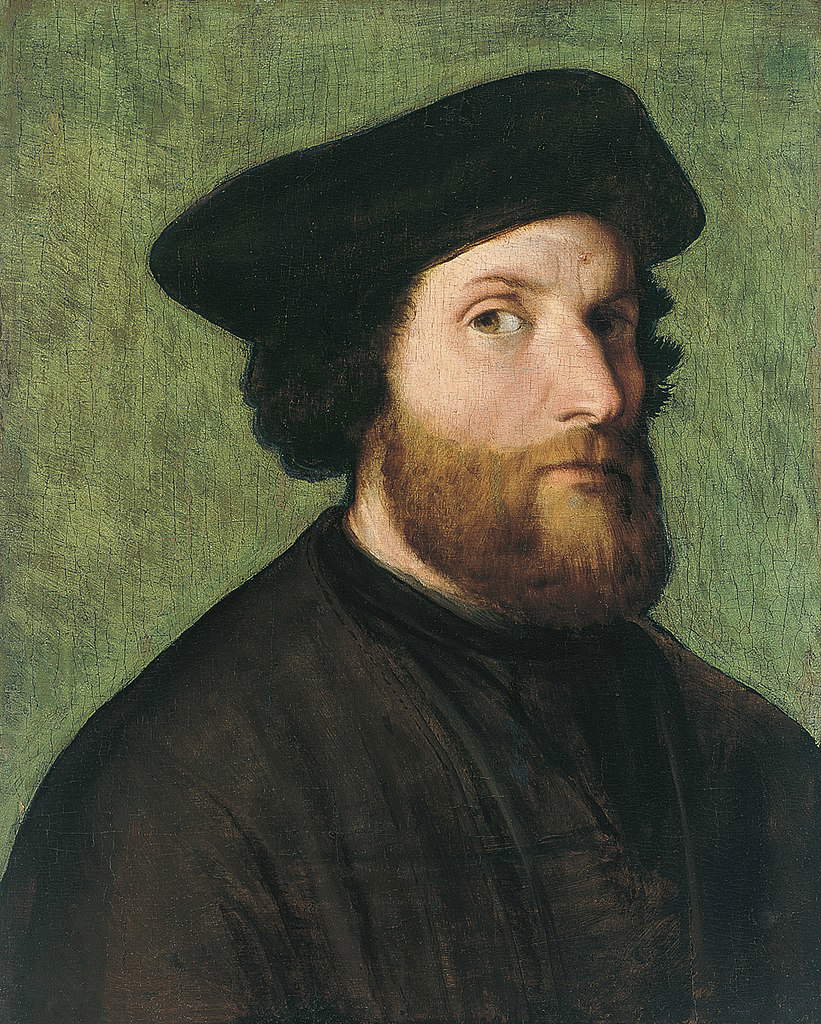 |
| Lorenzo Lotto (attributed), Self-Portrait? (1640s; oil on panel, 43 x 35 cm; Madrid, Museo Thyssen-Bornemisza) |
Lorenzo Lotto was born around 1480 in Venice. His father’s name was Tommaso, but we do not know what his trade was. We have very little information about his early years: according to Berenson, he trained in the workshop of Alvise Vivarini. In 1498 Lorenzo Lotto is documented to have been in Treviso on March 16. In the Venetian city, the painter stayed for a few years: he is still documented in Treviso in 1503, only to leave in 1506. In Treviso he executed, among other paintings, the portrait of Bernardo de’ Rossi, bishop of the city and promoter of an interesting circle of artists and intellectuals. In 1506 the artist painted the St. Christine Altarpiece for the church of Santa Cristina di Quinto (near Treviso) and the Asolo Altarpiece for Asolo Cathedral. In 1508 he was already active in working on the Polyptych of Recanati, one of his major early masterpieces, now preserved at the Pinacoteca Civica in Recanati. In 1509 he was in Rome where, perhaps invited by Donato Bramante, he worked on the papal apartments in the Vatican Palaces. In Rome he became acquainted with the art of Raphael, but Lorenzo did not leave his mark: his works were not appreciated and the artist left Rome the following year, never to return.
In 1511 Lorenzo Lotto was again in Recanati where he painted the fresco of St. Vincent Ferrer and the Transfiguration. In 1512 he finished the Deposition for the church of San Floriano in Jesi, now preserved in the Pinacoteca Civica of the Marche city. In 1513 the artist left the Marche to move to Bergamo, where he participated in a competition for an altarpiece for the church of Santi Stefano e Bartolomeo. The work would be finished three years later and is now known as the Martinengo Altarpiece after the man who financed the painting, Alessandro Martinengo Colleoni. Also in Bergamo, in 1517, he painted the Susanna e i vecchioni now in the Uffizi. Around 1518 he executed the portrait of Lucina Brembati now in Bergamo at the Accademia Carrara, while in 1521 he made the Santo Spirito Pala andthe San Bernardino Pala for the Bergamo churches of the same name, where the paintings still stand. By contrast, the Ponteranica Polyptych for the church of Saints Alexander and Vincent in the town near Bergamo, where it is still preserved, dates from 1522. In 1524 Lorenzo painted the Mystic Marriage of St. Catherine now preserved in Rome’s Palazzo Barberini. In the same year the Bergamo nobleman Giovan Battista Suardi commissioned him to paint the fresco decoration of the family oratory in Trescore Balneario with stories of Christ and saints, including Barbara and Brigida (to whom the oratory is dedicated): this is the Venetian artist’s greatest fresco masterpiece. Also in 1524, he was commissioned to create designs for the inlays of the choir of the basilica of Santa Maria Maggiore in Bergamo.
The artist returned to the Marche region in 1525: here he obtained new commissions. Feeling ready and mature for higher commissions than those to which he was accustomed, he planned to return to Venice: in 1527 he was therefore back in the lagoon, but he still failed to obtain important commissions. His only opportunity will be provided two years later when he paints St. Nicholas in Glory for the Church of the Carmine. The work was despised by his contemporaries, however, and the artist was forced to leave his hometown again. In 1531 he drew up his first will, in which he designated a hospital for the poor as his heir, while in 1532 he made a brief sojourn in Treviso and around this year probably returned to Le Marche. Around 1535 he painted the altarpiece with Saints Christopher, Roch and Sebastian probably for the Sanctuary of Loreto. In 1538, the Ancona gentleman Simone di Giovannino Pizoni commissioned from him the painting now known as the Pala dell’Alabarda preserved at the Pinacoteca Podesti in Ancona: it is one of the artist’s greatest masterpieces. Also in the same year, in Ancona, he began his Libro di spese diverse, a notebook in which Lorenzo jotted down all the information about the works he executed, as well as some of his thoughts. This is an invaluable document for reconstructing his activity and is an indispensable reference point for his biography and art.
In 1539 the artist painted the Madonna del RosariodiCingoli. In the same year he returned to Venice, where he was the guest of a cousin, who reciprocated with gifts (paintings and money). He stays in Venice for about ten years (except for a last brief stay in Treviso) but still fails to achieve the prestige and stability Lorenzo hoped for, partly because he cannot earn enough from his art for a decent living and is therefore forced to rely on the generosity of friends, whom he reciprocates with his paintings and some objects. In 1542 he painted theElemosina di sant’Antonino for the church of Santi Giovanni e Paolo in Venice. Around 1543 is the Portrait of a Gentleman with Gloves, probably the Venetian notary Liberale da Pinidello. In 1546, Lorenzo fell ill and was hosted by his friend Bartolomeo Carpan, while in 1548 Pietro Aretino wrote a sarcastic letter to Lorenzo that testifies to how hostile the Venetian environment was to him. In 1549, from Ancona he obtained a commission from local nobleman Giovanni Francesco Tudini: it was theAssumption for the church of San Francesco alle Scale. He decided to leave Venice never to return, and settled permanently in the Marche region. Around 1550 he painted the Portrait of a Crossbowman now in the Pinacoteca Capitolina in Rome. The painting was executed for mastro Battista, a carpenter portrayed in the work, in exchange for some carpentry work the craftsman had done for the painter. In the same year, to scrape together some money he sells several paintings in his possession at auction. Lorenzo Lotto moved to Loreto in 1552: here, he matured the decision to become an oblate of the Holy House (he would become such in 1554). In Loreto he spends his last years. He began his greatest masterpiece of his last years, the Presentation in the Temple now in the Apostolic Picture Gallery of Loreto, on which he worked for the rest of his days. The last notation on the Book of Miscellaneous Expenses dates from 1556, and probably between 1556 and 1557 the artist died in Loreto.
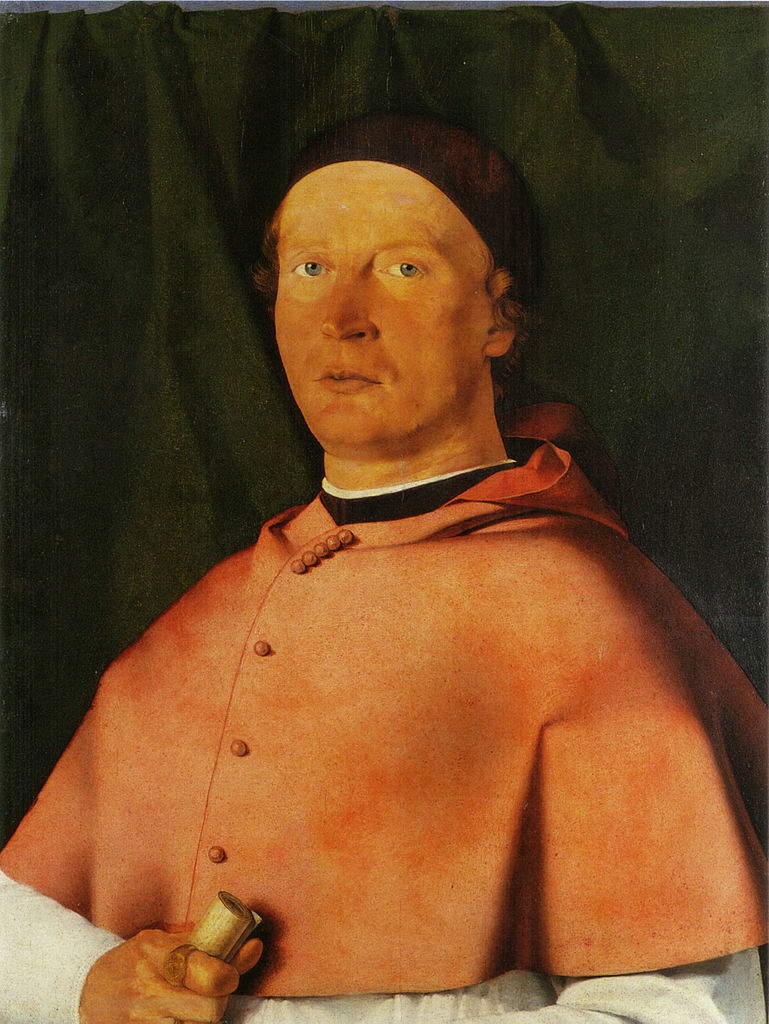 |
| Lorenzo Lotto, Portrait of Bishop Bernardo de’ Rossi (1505; oil on panel, 54 x 41 cm; Naples, Museo Nazionale di Capodimonte) |
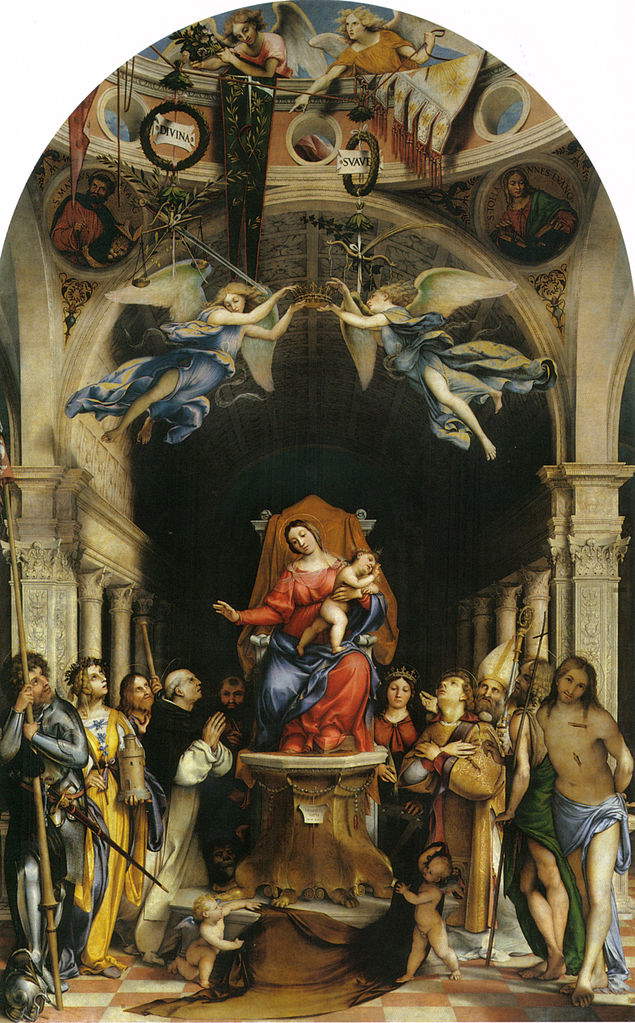 |
| Lorenzo Lotto, Martinengo Altarpiece (1513-1516; oil on panel, 520 x 250 cm; Bergamo, Church of Saints Bartholomew and Stephen) |
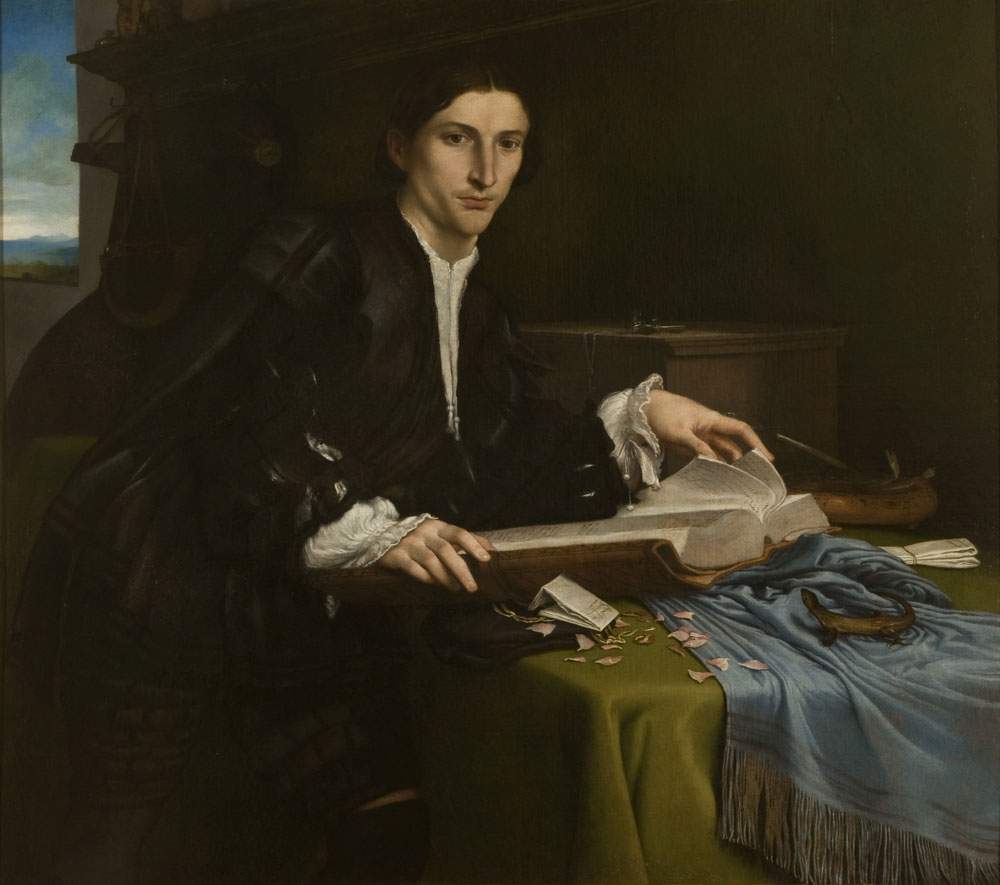 |
| Lorenzo Lotto, Portrait of a Gentleman of the House of Rovero (c. 1530-1532; oil on canvas, 97 x 110 cm; Venice, Gallerie dell’Accademia) |
The first place to start on a journey through Lorenzo Lotto’s art is the portrait of the artist’s patron in Treviso, namely Cardinal Bernardo de’ Rossi, who came from the noble Rossi family of Parma and was appointed bishop of Treviso in 1499. The bishop is portrayed wearing a dull red mozzetta, a ring on his index finger with a rampant lion on it, the family’s coat of arms, in a solemn and official pose: this detail, however, does not prevent Lorenzo Lotto from creating an extremely realistic portrait. The painter, without any filter, restores with great precision the complexion of the personage, the skin with all its imperfections, and also shows great psychological penetration in realizing the gaze of Bishop Bernardo de’ Rossi, which denotes coolness and confidence, a confidence also underscored by the gesture of the hand firmly clutching the roll of parchment. The bishop is illuminated by an almost dazzling light, of Nordic ancestry, while the great realism derives from a reading of Antonello da Messina’s portraiture. The work is signed and dated, a frequent custom for Lorenzo Lotto; in this case it is a painting from 1505. On the other hand, perhaps the most interesting work of this period is from the following year, namely the Asolo Altarpiece, which summarizes several of the suggestions Lorenzo Lotto received in the early stages of his career: the landscape that refers to some Giorgionesque solutions, the colors of the sky that are those of Venetian painting of the time, the Madonna Assumption inserted in a mandorla made of clouds (and borrowed from the art of Perugino, who stayed in Venice at the end of the 15th century: Lorenzo Lotto probably knew him on this occasion), the characters and some landscape elements that are marked by outline, a sign that Lorenzo Lotto gave more importance to drawing than to color, in disagreement with the painting of his native areas. The signature and date are on a crumpled sheet at the bottom center of the composition, an expedient often used by Antonello da Messina. Note then the freedom of composition and poses, which denote Lorenzo Lotto’s very unconventional attitude, his independence, and his versatility.
The Bergamasque period is exemplified by the Pala Martinengo, so called because it was financed by the condottiero Alessandro Martinengo Colleoni. The work was completed in 1516 and originally consisted of several parts, now divided among various museums. The central compartment is a Sacred Conversation with the Madonna and Child in the center and as many as ten saints on the sides (Alexander, Barbara, James, Dominic and Mark on the left, Catherine of Alexandria, Stephen, Ambrose, John the Baptist and Sebastian on the right). The saints occupy a vertical space that corresponds to less than one-third of the overall space of the altarpiece: paramount importance is given to the architecture (a majestic and magnificent barrel vault with coffers, foreshortened in perspective, ending at the top with a balustrade from which two angels look out, in a solution reminiscent of the oculus in Mantegna’s Bridal Chamber). The angels are marked by a strong anti-Classicism: they are portrayed in a moment of work, as they are intent on arranging the festoons with garlands: rather than two angels they look like two workers, and as a result there is disorder at the top, there is a lack of symmetry, the tapestries are leaning without criteria since they still have to be arranged, and even the garlands hang in a disorderly manner. They work to such an extent that some of the saints, for example Saint Ambrose, seem to be more interested in them than in Our Lady. The two putti at the foot of the throne among others are also working, for we see them intent on spreading a cloth over the marble base of the throne. This is therefore an apparently traditional painting, but in reality it is very unconventional, not least because of the way the saints are depicted, who in many cases do not appear to us as ethereal and solemn figures, which was often the case in the art of the time, but are posed as real figures and fervent in their religiosity, portrayed in naturalistic poses and also attentive to what is going on around them. Lorenzo Lotto’s painting, in contact with Lombard art, thus becomes charged with a new tension and a more pronounced expressiveness.
Among the masterpieces of his maturity, it is possible to mention the Alabarda Altarpiece, a rather complex painting: it is a sacred conversation with the Madonna and Child in the center flanked by four saints (Stephen, John the Evangelist, Simon Zealot, and Lawrence), and two angels above who are crowning the Virgin. The throne on which Mary sits has a very unique base, formed by two symmetrical steps, and has the painter’s signature in the center. It can be seen that Simone Zelota is leaning on a broken halberd with the tip pointing downward: a few years earlier, precisely in 1532, the city of Ancona had been occupied by the Church, which had annexed it to the Papal State, and the government of Ancona had been entrusted to Cardinal Benedetto Accolti, a character with despotic manners who exercised real tyranny over the city, and was therefore deposed from his post and imprisoned shortly afterwards. The broken halberd thus represents, on the one hand, the end of Benedetto Accolti’s tyranny, because the cardinal for his own protection used a corps of lansquenets whose weapon was the halberd, but on the other hand it could also be a message of hope and an anti-war message, with the weapon broken and turned downward so that it cannot offend. On the compositional level, the painting is rather traditional, but it denotes great modernity if one observes the very free poses of the saints and also the rather haphazard arrangement of their attributes (note, for example, the gridiron of St. Lawrence). And, again with regard to the figure of Saint Lawrence, note how his face is formed almost through the light that invests it, a process that anticipates Caravaggio’s painting by several years.
As for his late activity, on the other hand, Lorenzo Lotto’s last work is considered the Presentation in the Temple in the Apostolic Picture Gallery of Loreto. The painter’s sign appears very tired and labored, and the same of could of the drafting of the colors: one can clearly see that this is the work of a painter almost 80 years old, and yet this does not mean that Lorenzo Lotto stopped innovating and astonishing. The detail that probably strikes the viewer the most is that of the temple altar resting on human feet, a novel and peculiar solution that reveals the extreme imagination of this 16th-century genius, although the reason for this depiction is unknown. The setting of the painting is also highly original: in fact, the composition appears to be divided in two by the temple choir, which is elevated and beautifully foreshortened in perspective. Moreover, it is noted that from the door on the right on the choir, near the stairs, two friars are entering, although it is not known why the painter decided to provide this depiction. According to some scholars, the friar who has just crossed the threshold could be a self-portrait of the painter, but it is not possible to establish this with certainty. And still remaining in the realm of hypotheses, the choir that can be seen in the upper part of the composition could be that of the choir chapel of the Basilica of Loreto, but again there is no evidence to know if this is really the case. So, Lorenzo Lotto, even at the end of his career and years continues to experiment, to find original solutions, to innovate and of course to amaze those who look at his wonderful works of art.
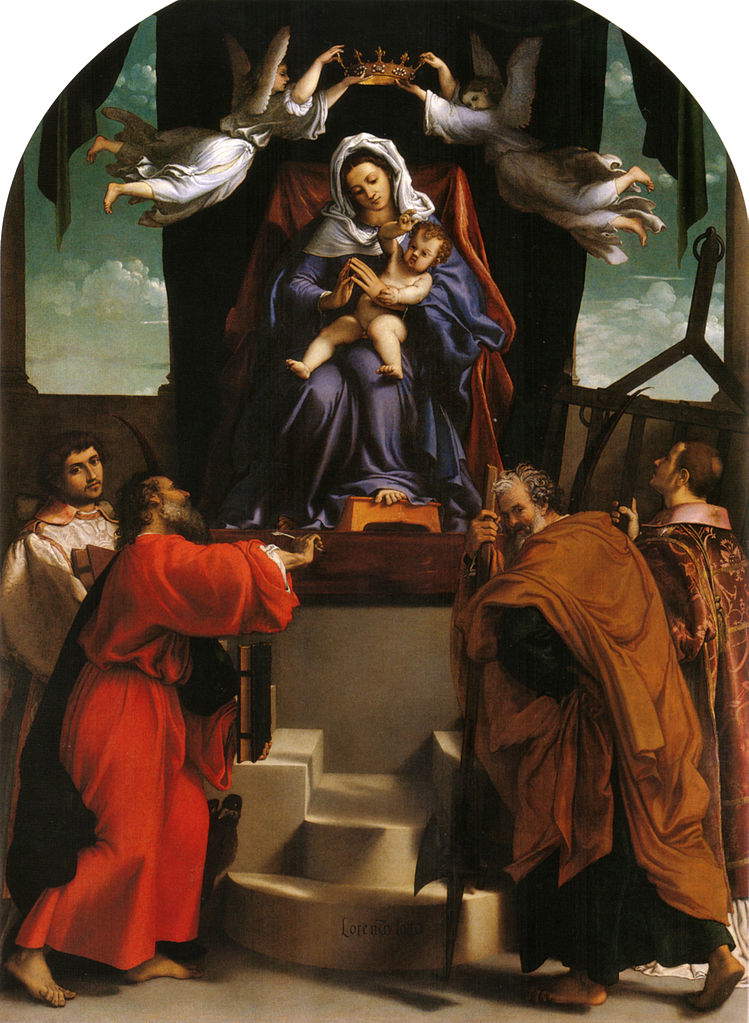 |
| Lorenzo Lotto, Altarpiece of the Halberd (c. 1539; oil on canvas, 294 x 216 cm; Ancona, Pinacoteca Civica Francesco Podesti) |
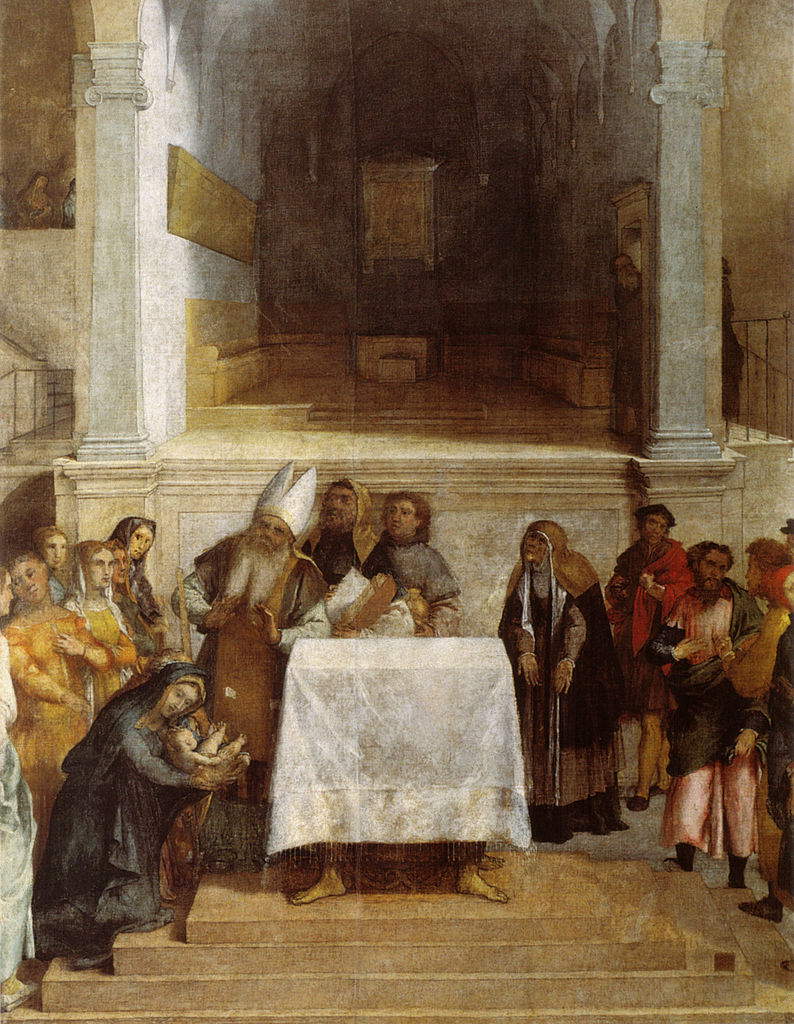 |
| Lorenzo Lotto, Presentation in the Temple (1552-1556; oil on canvas, 172 x 136.5 cm; Loreto, Museo pinacoteca della Santa Casa) |
There are many places that preserve the works of Lorenzo Lotto. Some are found in Venice, his hometown: these are the St. Nicholas in Glory in the church of Santa Maria dei Carmini, the Sick Young Man preserved in the Gallerie dell’Accademia, theElemosina di sant’Antonino in the church of Santi Giovanni e Paolo, the Gentiluomo con catena in the Cini Foundation, and the Pala di San Giacomo da l’Orio in the church of the same name. Some early works, such as the Madonna and Child, Saint Peter Martyr and a Donor and the Portrait of Bishop Bernardo de’ Rossi, are at the Museo Nazionale di Capodimonte in Naples, while the Uffizi has a Portrait of a Young Man (as well as two more mature works-Susanna and the Old Men and the Holy Family with Saints Jerome and Anne). In the Treviso area, however, one can admire the Altarpiece of Santa Cristina al Tiverone, in the church of Santa Cristina in Quinto di Treviso.
You can delve deeper into Lotto’s Bergamo period with a tour of churches and palaces in and around the city: the Carrara Academy, the church of Saints Bartholomew and Stephen (where the central compartment of the Martinengo Altarpiece is located), the churches of Santo Spirito, San Bernardino in Pignolo, San Michele al Pozzo Bianco and Sant’Alessandro della Croce in Bergamo, and the church of Santa Maria Maggiore, where one of his most unique masterpieces (the wooden inlays of the choir: Lorenzo is credited with the cartoons), and outside the city the church of Saints Alexander and Vincent in Ponteranica, the frescoes in theSuardi Oratory in Trescore Balneario. Several important portraits by Lorenzo Lotto are preserved at the Pinacoteca di Brera(read more about them here). You can also take a real Lotto tour in the Marche region (a special website has also been set up): one can find his works at the Pinacoteca Podesti in Ancona (the Alabarda Altarpiece, in the church of San Francesco alle Scale (the Assumption), at the Pinacoteca Civica in Jesi(read here an in-depth look at these five masterpieces), at the church of San Domenico in Cingoli, at the church of Santa Maria in Monte San Giusto, at the Museo Civico di Villa Colloredo Mels in Recanati, at the Museo del Santuario di Loreto, and at the Museo di Arte Sacra in Mogliano.
Outside national borders one encounters important works by Lotto in many museums around the world such as the Louvre, the National Gallery in London, the Kunsthistorisches Museum in Vienna, the Gemäldegalerie in Berlin, the Hermitage in St. Petersburg, and the National Gallery in Washington.
 |
| Lorenzo Lotto: life and works of a restless artist |
Warning: the translation into English of the original Italian article was created using automatic tools. We undertake to review all articles, but we do not guarantee the total absence of inaccuracies in the translation due to the program. You can find the original by clicking on the ITA button. If you find any mistake,please contact us.